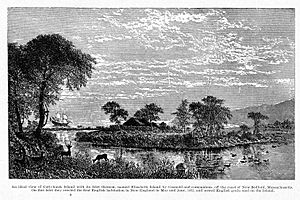John Brereton facts for kids
John Brereton (born around 1571/1572 – died around 1632) was an English explorer and writer. He wrote about a trip to the New World in 1602. This journey was led by Bartholomew Gosnold.
Brereton's writings were the first to describe what Europeans saw when they explored Cape Cod and the areas around it. His book, published in 1602, helped encourage England to start colonies in what was then called "the North part of Virginia." This area later became known as New England.
John Brereton's Early Life
Historians believe John Brereton was a clergyman, which means he was a church leader. He was born around 1571 or 1572 in East Anglia, England. His father, Cuthbert Brereton, was a sheriff in Norwich.
John went to Norwich School and then to Gonville and Caius College, Cambridge when he was seventeen. He earned his first degree in 1593 and a master's degree in 1596. He became a priest and was appointed a curate in Lawshall, Suffolk, in 1598.
It was likely in Suffolk that Brereton met Captain Gosnold, who lived nearby. He also probably met Richard Hakluyt, a famous writer who published many stories about voyages and discoveries, especially in America.
After his journey to Virginia, Brereton lived a quiet life as a church leader. He became the Rector of Brightwell, Suffolk, in 1619. He might also be the same John Brereton who was Rector of St Peter Mancroft in Norwich and passed away in 1632.
The Exciting Voyage to New England
Brereton joined Captain Bartholomew Gosnold and others on a trip to explore and try to settle in the land later called New England. On March 26, 1602, twenty-four gentlemen and eight sailors left Falmouth, England. They sailed on a small ship called the Concord. Twelve of the gentlemen planned to stay and settle, while the other twelve would return home with goods they traded.
Instead of taking the usual long route by the Canary Islands, Gosnold steered his ship directly west. This was a new way to sail to America. It saved a lot of time and distance!
By May 15, the travelers reached a headland they named Cape Cod. Gosnold, Brereton, and two others were the first English people to step onto the white sands of New England.
After sailing around Cape Cod and past Nantucket, they stopped at Martha's Vineyard. They then entered Buzzard's Bay, which they called Gosnold's Hope. Finally, they reached Cuttyhunk Island, which they named Elizabeth's Island.
They decided to try and settle on Elizabeth's Island. In just nineteen days, they built a fort and a storage building on a small island within a lake. They started trading furs and animal skins with the local people. They also traded for sassafras, a plant that was very valuable back in England.
They planted wheat, barley, and peas. In only two weeks, the young plants had grown more than nine inches! The land was very fertile and full of resources.
However, the group soon realized they were too small to start a successful colony. Their supplies would only last about six more weeks. So, the entire group decided to sail back to England. The return trip was very fast, taking only five weeks. They landed in Exmouth on July 23. The goods they brought back, especially the sassafras, sold for a lot of money, making a great profit.
Brereton's Famous Book
After his journey, John Brereton wrote a book called A Briefe Relation of the Description of Elizabeth's Ile, and some others towards the North Part of Virginie. It was published in London in 1602. A second version came out the same year with a slightly different title.
Brereton's book was well-written and clear. Its main goal was to show how great the possibilities were for England to start colonies in New England. His book helped inspire many more trips across the Atlantic Ocean. Over the next six years, there were at least twenty-three crossings by English ships!
Even famous explorers like Captain John Smith were inspired by Brereton's account. Captain Smith later wrote that Brereton's book made him want to join Gosnold on a future voyage. This later trip led to the founding of the Virginia colony in 1607.


